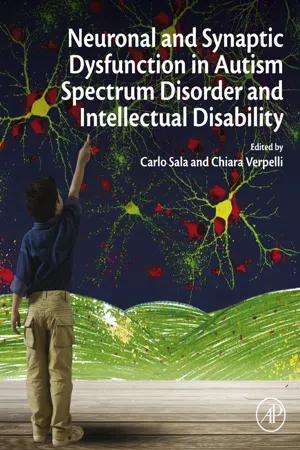
Neuronal and Synaptic Dysfunction in Autism Spectrum Disorder and Intellectual Disability
- 394 pages
- English
- ePUB (mobile friendly)
- Available on iOS & Android
Neuronal and Synaptic Dysfunction in Autism Spectrum Disorder and Intellectual Disability
About this book
Neuronal and Synaptic Dysfunction in Autism Spectrum Disorder and Intellectual Disability provides the latest information on Autism spectrum disorders (ASDs), the lifelong neurodevelopmental disorders that present in early childhood and affect how individuals communicate and relate to others and their surroundings.In addition, three quarters of ASD patients also manifest severe intellectual disability. Though certain genes have been implicated, ASDs remain largely a mystery, and research looking into causes and cellular deficits are crucial for better understanding of neurodevelopmental disorders.Despite the prevalence and insidious nature of this disorder, this book remains to be an extensive resource of information and background on the state of current research in the field.The book serves as a reference for this purpose, and discusses the crucial role synaptic activity plays in proper brain function. In addition, the volume discusses the neurodevelopmental synaptopathies and serves as a resource for scientists and clinicians in all biomedical science specialties. This research has been crucial for recent studies that have provided a rationale for the development of pharmacological agents able to counteract functional synaptic anomalies and potentially ameliorate some ASD symptoms.- Introduces the genetic and non-genetic causes of autism and associated intellectual disabilities- Describes the genes implicated in autistic spectrum disorders and their function- Considers major individual genetic causes of autism, Rett syndrome, Fragile X syndrome, and other autism spectrum disorders, as well as their classification as synaptopathies- Presents a thorough discussion of the clinical aspects of multiple neurodevelopmental disorders and the experimental models that exist to study their pathophysiology in vitro and in vivo, including animal models and patient-derived stem cell culture
Frequently asked questions
- Essential is ideal for learners and professionals who enjoy exploring a wide range of subjects. Access the Essential Library with 800,000+ trusted titles and best-sellers across business, personal growth, and the humanities. Includes unlimited reading time and Standard Read Aloud voice.
- Complete: Perfect for advanced learners and researchers needing full, unrestricted access. Unlock 1.4M+ books across hundreds of subjects, including academic and specialized titles. The Complete Plan also includes advanced features like Premium Read Aloud and Research Assistant.
Please note we cannot support devices running on iOS 13 and Android 7 or earlier. Learn more about using the app.
Information
Experimental Tools for the Identification of Specific Genes in Autism Spectrum Disorders and Intellectual Disability
Abstract
Keywords
Autozygosity mapping; Balanced translocation breakpoint mapping; Candidate gene approach; Copy number variations; Exome sequencing; Linkage analysis; Next-generation sequencing; Positional mapping; Whole-genome sequencingPositional Mapping
Linkage Mapping
Table of contents
- Cover image
- Title page
- Table of Contents
- Copyright
- List of Contributors
- Preface
- Acknowledgments
- Part I. Autism Spectrum Disorders and Intellectual Disability:Genetic and Non-Genetic Causes
- Part II. Function of Mutated Genes in Intellectual Disability (Id) and Autism
- Part III. Experimental Models, Clinical and Pharmacological Aspects of Major Asds, and Intellectual Disability Syndromes
- Index